Establishing the Tropical House at the National Botanic Garden of Wales – Early days
by Ann C. Maloney and Peter J. Hoare
(Gardeners responsible for the Tropical House)
 The Tropical House at the National Botanic Garden of Wales
The Tropical House at the National Botanic Garden of Wales
The idea for a Tropical House at the National Botanic Garden of Wales was first voiced in 2005. It was felt that it would fit very well into the Double-Walled Garden, where a stove house had originally stood in the 1800, it would be a partner, albeit on a much smaller scale, to the Great Glasshouse, erected in 2000, that now houses those plants that favour a Mediterranean type climate. This had been designed by architect Sir Norman Foster.
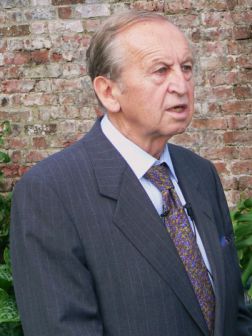 John Belle
John Belle
The Architect
Architect John Belle, who originally came from Pontcanna, Cardiff, was approached and it was he who designed the Tropical House and officially opened it on July 19th 2007. Belle had already been involved with a number of other prestigious projects such as the Grand Central Terminal (which had been renovated and revamped over a period of ten years), the Ellis Museum of Immigration and the Chrysler Building. The two latter have both been awarded the highest accolades. The Tropical House was, however, Belle’s first project in his country of birth, Wales, and he said of it: “Designing the Tropical House, a building that is all about the connection between the world of plants and the realm of architecture, provided a wonderful opportunity for me to reconnect with my roots. I don’t think there could have been a more appropriate project for me at this stage in my career”.
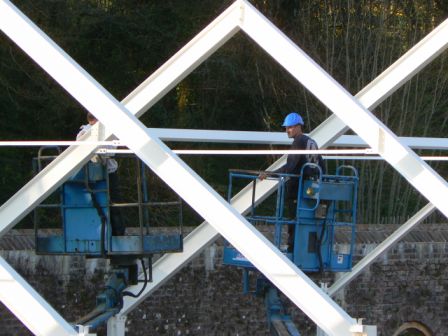 Work in progress
Work in progress
The Tropical House
The Tropical House, measuring 36.592 X 10.6m, was designed to meet the conditions conducive to the growth of all the plants that it would eventually contain. Situated amongst the systematic beds allocated to monocotyledonous and basal angiosperm plants, the monocot theme continues as the visitor enters the Tropical House. It has a minimum night temperature of 16oC (62oF), reaching an optimum daytime temperature of 18oC (66oF). At 22oC (72oF), the vents open; the humidity level, which is so necessary for successful orchid and epiphyte culture in general, is set at 75% relative humidity, reaching a value of 90% in summer. Ventilation is achieved by means of fans and automatic vents as well as circulatory fans, whereas the triple-layered polycarbonate roof enables the filtration of UV light, the whole regulated by a climate control computer.
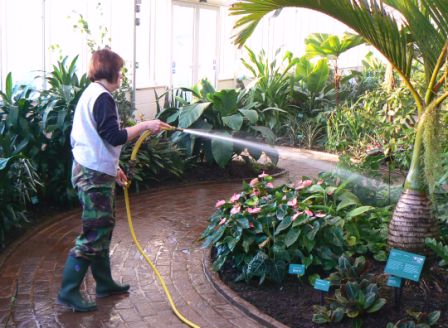 Plants being watered in the Tropical House
Plants being watered in the Tropical House
The interior design needed to be imaginative and provide plenty of planting areas, yet have winding pathways that would guide visitors towards the most exciting plants. Prior to its erection, visitors would often ask where they could find the orchids and indeed, even back then, there were some specimens of Cypripedium reginae and Bletilla striata growing in the Walled Garden, some species of Dactylorhiza in the Meddygon Myddfai (Physicians of Myddfai) Garden and Epipactis helleborine in the rockery outside Principality House. Now, however, we had the opportunity to display tropical orchids, and in particular, epiphytic species, much as they occur in nature.
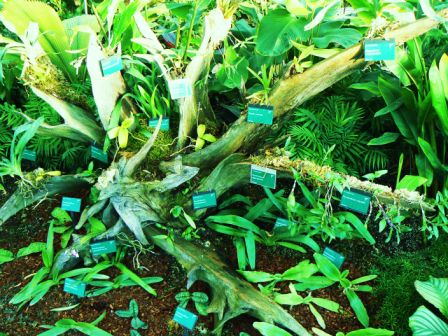 New Orchid Plants
New Orchid Plants
The excitement and historic significance of being involved in establishing the Tropical House from scratch resulted in some very mixed emotions. On the one hand, there was the thrill of being able to grow some of the World’s most beautiful, exotic and fragrant flowers. On the other, we were very aware that we had little experience of growing orchids and yet, the success or otherwise of the orchids would depend entirely upon us. This was further exacerbated by the fact that within a couple of months, the house would be open to the public. It is at this point that we asked Dr. Kevin L. Davies for his invaluable help. He shared with us his knowledge and experience of orchid biology and orchid cultivation and guided us through all the difficult decisions that we had to make. After several meetings and prolonged discussions, it was finally decided that the minimum night temperature should be set at 62oF in order to accommodate all the needs of the various orchids and accompanying plants that we intended to include in this new edifice. We decided mostly to concentrate on orchid species. After all, conservation of wild species is one of the most important roles of any botanic garden. Some hybrids, however, were also included in order to provide some colour in the early days before any of the species had had a chance to become established. Furthermore, with the recent surge of interest in Phalaenopsis hybrids amongst the public, it was felt that the inclusion of a small number of these plants would be popular as the general visitor would be able to relate better to them than to some of the other orchids included which were often small species with flowers barely a few millimetres in diameter. Phalaenopsis species were also included so that direct comparisons could be made between the colourful Phalaenopsis hybrids and their more modest, yet beautifully coloured parents. Some species such as Angraecum sesquipedale were also chosen for educational purposes. This species has a 13 inch floral spur, and although its pollinator was not known at the time, Darwin predicted that it was a moth with a 13 inch long proboscis! After Darwin’s death, the moth was finally discovered and named Xanthopan morganii praedicta.
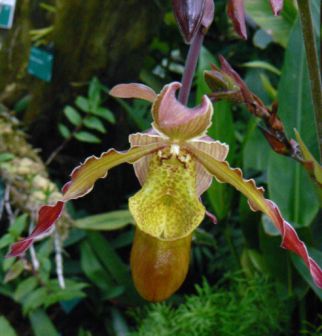 Phragmipedium Orchid
Phragmipedium Orchid
Orchids were obtained from both British and European nurseries, as well as established botanical gardens such as those at Kew, Edinburgh, Glasgow, The Eden Project and Swansea. Once, when returning from an orchid-buying spree in Devon, the back of our van flew open and the catalytic converter fell off, but even this temporary inconvenience was well worth all the enjoyment that we had in establishing our orchid collection.
By now, we needed more space to grow all the newly acquired plants before introducing them to the main collection in the Tropical House. As a result, our former quarantine house was modified for this purpose.
Our finest hour had come, planting!
We had just two days left for planting the Tropical House and before it would be open to the public. The builders had not yet finished the pond and path. Some architecturally interesting stumps of swamp oak had been donated but mounting orchids on them proved rather a challenge as we had not had a chance to practise. After experimenting with various techniques, we found that the best method was to pack the roots with moss and then attach them to the stumps by means of nylon fishing line, which can hardly be seen, and securing the whole by using a staple gun. The nylon line was checked at intervals to ensure that it was not too tight. Since then, we have progressed to mounting orchids on cork bark and even onto steel supporting posts on the back wall of the house. Recently, we have introduced a dead alder so as to provide much-needed height and this too has been covered with epiphytes. Horticultural projects nearly always, it would seem, just meet the set deadline. Just look at Chelsea!
The Orchids
Here is a small selection of our orchids. How these names keep changing! Bulbophyllum lobbii which is found in lowland and montane forests of Indonesian and Malaysian Islands and is mounted on Pandanus. Prosthechea Brassavolae, an epiphyte and occasional lithophyte from the wet forests of central America, grows on one of the swamp oak stumps, whereas Prosthechea vespa from the pine forests of South America can grow as a lithophyte or terrestrial and here, is planted in the ground. (For further information and news on the tropical orchids, check the National Botanic Garden of Wales website.)
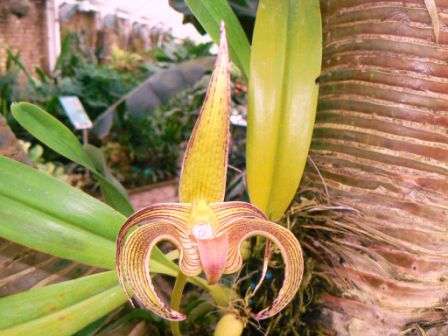 Bulbophyllum lobbii
Bulbophyllum lobbii
The everyday Nitty Gritty!
Some areas are watered and floors are soaked on a daily basis. Beginning in April, all plants are fed with a proprietary fertilizer. In keeping with Garden policy, chemical control of pests is seldom used. Instead, biological control is usually employed, although individual plants infected with scale, sooty mould and thrips are sprayed with a soap/oil-based product and methylated spirit is applied with a paint brush to mealy bug. The latter is probably the most prevalent pest in this particular glasshouse.
The way forward
Like any developing collection, in time, we would like to replace certain plants with others of greater scientific interest whilst simultaneously keeping those which are most popular with the public. Given the scientific and historical importance of the orchid collection once grown on the Penllergare estate in the 1800s (See Richard Morris’s article on this website)and which is situated fairly close to the Garden, we hope to cultivate those species known to have been grown back then by John Dillwyn Llewelyn. Eventually, we would also like to maintain the national collection of a particular orchid genus (yet to be decided) and perhaps, resources permitting, grow orchids from seed and thereby contribute towards their conservation. However, for the moment, ‘slow and steady does it’, but do please continue to check this website for updates.
Orchids and early photography
In October 2013, Laura Reeves, the successful recipient of the Jane Phillips Award for Art, approached our chairman seeking information about the orchid house at Penllergare and the plants that were grown there by the pioneer photographer John Dillwyn Llewelyn, with a view to undertaking a project based on one of JDLl’s early photographs of the orchid house and its occupants. Laura has the following to say:
“The Jane Phillips Award was launched at the Mission Gallery, Swansea, on 5th August 2011. Intended as a memorial to Jane Phillips (1957 – 2011), Mission Gallery’s first Director, the Award is a legacy to Jane’s passion for mentoring and nurturing talent, consistently supporting young, emerging artists across the Visual and Applied Arts in Wales and beyond.
 Laura Reeves will be presenting her project, research and artwork focusing on a photograph of John Dillwyn Llewelyn’s orchid house. Laura Reeves has been investigating this historical document and the links between it and existing orchid collectors in Swansea. Her artist practice revolves around ideas relating to the said photograph. She has previously worked with themes of revival and the activation of lost stories.
Laura Reeves will be presenting her project, research and artwork focusing on a photograph of John Dillwyn Llewelyn’s orchid house. Laura Reeves has been investigating this historical document and the links between it and existing orchid collectors in Swansea. Her artist practice revolves around ideas relating to the said photograph. She has previously worked with themes of revival and the activation of lost stories.
http://www.axisweb.org/features/profile/open-frequency/laura-reeves/ ”.
Laura intends coming along to some of the Orchid Study Group talks in order to interview members about their collections and what it is that inspires and makes them so passionate about collecting orchids. She will then present her work to the OSG in November 2014.
Orchid Day at Dyffryn Gardens
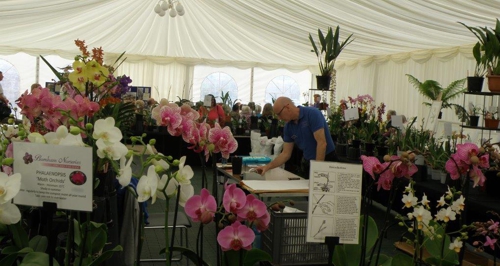
On Saturday, 7 June the Orchid Study Group held its very first Orchid Day at Dyffryn Gardens (National Trust) in the Vale of Glamorgan. Whilst being a new venture, the day was considered to have been a great success. Burnham Nurseries tempted visitors with a splendid collection of exotic orchids and Trey Sanders offered an excellent collection for those in search of the unusual and rare. Local botanical artists impressed visitors with their beautiful botanical paintings and artwork. An excellent collection of books was for sale and Cardiff and the Vale Orchid Society and the Penllergare Trust kindly exhibited. Throughout the day there were talks to tempt beginners and those already passionate about orchids.
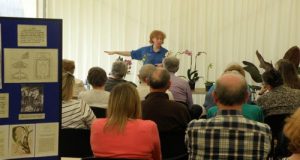

Many thanks to all who visited the event and our appreciation to our hosts, the National Trust, for inviting us.
Lynne Harrendence
Secretary
Orchid Study Group